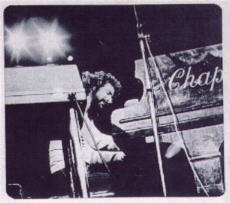Jennifer L Perez was kind enough to
translate and send Majicat copies of a Spansh magazine called Mundo Joven
September 15, 1973. This is what she says about the article and translation .
"Please keep in
mind that the author is not straight on a lot of facts, and this being a European
publication, often goes off on an "intellectual" tangent. The name of the
magazine is translated as ‘Young World" and was geared for the high school and
college-aged crowd. I also don’t know why the author of this article refers to
"Foreigner" as "Stranger". Forastero means stranger, while estrangero
means foreigner. I guess he didn’t do a hot-shot job in translating the word
foreigner. He didn’t do a good job copying some of the song titles down correctly
either! And keep in mind that cultures have different forms of expression that are simply
not translatable."
- THE SUITE OF THE STRANGER
- CAT STEVENS
- Author: V. Del Pozo
Perhaps I can begin this
article about Cat Stevens by telling you that he is one of the last romantics of English
pop music. Perhaps it can begin that way. Cat Stevens is a romantic interpreter with a
great homesickness in his voice and in his thoughts. Behind this romanticism, one
doesn’t know what reasons to put forth, whether of psychological, social or creative.
It could be that the definitive sum of all of this is that Cat Stevens began with
"Lady D’Arbanville" and today has returned with his fifth LP, titled
"Foreigner". Cat Stevens has leapt from that which we may call English
"rock". Neither has he needed to ingratiate himself with the worldwide public or
marketing ploys as that used by "Gay Power". (Gay Power is similar to Act Up
here in the US.) Neither has his image needed to be placed on billboards like Gilbert
O’Sullivan.. .His image is his own sound and in that sound, there is no need for much
studio effects: one guitar, one voice and sound, and his own sensitivity. That is all. And
that is, for Cat Stevens y his followers, more than sufficient.
THE BIOLOGICAL
ROOTS OF CAT DEMETRI GEORGIOU
Since listening to Cat
Stevens’ "Lady D’Arbanville", I have always thought that Cat Stevens,
eventhough he was born in 1948 in a London neighborhood like that of Hammersmith, he was
born biologically with the sun and the temperament of the Mediterranean people and the
sensitivity of an Anglo-Saxon, if not that of a Mediterranean. Son of a Greek father and
Swedish mother, Cat Demetri Georgiu spent his infancy and adolescence in London. He
attended schools in the West End. Regardless, the constant business of his Parents’
restaurant, the Moulin Rouge, which is still open in one of the most bustling zones of
London, has left Cat with loneliness, and perhaps that and his withdrawn temperament made
him a taciturn and lonely boy.
After completing his high
school, he enrolled in Hammersmith School to study art and drawing. It was there that he
really began to get into music. Cat was then 17 years old: it was 1965 and in London,
there was not a better opportunity for all youths to be interested in music.
During his first year as a
student in the Fine Arts, he began being noticed when he met with his friends, playing the
guitar songs that were current hits. During one of those days, when he was hanging out
with his friends, a man by the name of Mike Hurst heard him and would decide his artistic
future.
Mike Hurst, a member of the
‘Springfields", along with Dusty and Tom, heard some of his songs that Cat had
taped and based upon that, obtained for him a demo session that was taped and then played
for one of Decca’s chief executives, Dick Rowe. Dick Rowe immediately signed Cat
Stevens that same day for his first contract.
With Cat, the executives at
Decca thought they had discovered the goose that layed the golden egg and they obliged Cat
to prepare his material with great symphonic sounds. Then a great publicity campaign began
to launch the new product for the English market: Cat Stevens.
Cat Stevens was then 18
years old when he started his first monstruous tour in Great Britain, which obliged him to
complete a series of fifty recordings. Subsequently, Cat started to feel unhappy with
himself and with the producers and consultants that were over him. As a result, he fell
ill and his physician prohibited all types of activities.
This, which any artist
would have considered a disaster, to Cat Stevens, it permitted him six months of absolute
spiritual rest and returned to him his psychological independence and allowed him to
restart his solo career.
FROM ‘LADY
DARBANVILLE" TO ~‘O CARITAS"
The six months in a
sanatorium gave Cat Stevens his freedom from his record company, since his contract was
terminated with Decca. At the same time, it gave him artistic freedom and during this
time, he composed songs and wrote lyrics that would explode on the English-speaking market
causing a deep impact without much push. Not content with his recuperation, when he was
discharged from the sanatorium, he refused to sign a contract with Decca, despite the
splendid offer that they made, and he went home to continue writing and composing.
One of the few persons whom
was able to listen to his new songs was Chris Blackwell, a manager at Island. Chris
offered Cat the opportunity to record what he wanted and in the manner he wanted, allowing
him to select the songs and hire the musicians that he wanted for his recordings.
Cat considered the offer
for a few days and selected the material that would constituted his first album. After he
finished recording, Cat signed an exclusive contract with Island.
Cat Stevens choose his
musicians randomly and with the assistance of Paul Samwell-Smith, he completed the
recordings for his album "Mona Bone Jackon". Eighteen months had passed since
Cat Stevens was able to edit a single song.
In this album, he had a
great song: "Lady D’Arbanville". This song, which was released as a single,
opened the doors to the market to his LP. The song was composed while he was recuperating
in the sanatorium and he related his experience with a girl from the town of Arbanville.
The song had an enormous appeal at the European level, and Cat overnight saw the launching
of a great career as composer and solo artist.
With the same producer and
musicians, in the next six months, he released a second album with material that he had
prepared during the eighteen months of rest that was mentioned above. This second album
was called ‘Tea for the Tillerman". With this album, his name was established at
the international level and opened up the American market. On the other hand, this second
album, more than the first, was the greatest artistic work from the psyche of a
Mediterrean male. From him, other stand-out singles were "Where Do The Children
Play?", "Sad Lisa" and ‘Wild World".
In 1971, his third album,
titled "Teaser and the Firecat" was released, with some great singles such as
"Tuesday’s Dead", "Morning Has Broken", "Moonshadow"
and "Peace Train".
In October, 1972, his
fourth album was released for sale, and like the previous albums, went gold in the USA and
England the month prior to its’ release; it was "Catch Bull at Four’. This
album’s first release was mysteriously a Greek-Byzantine religious song titled
"0 Caritas" and it was sung in Latin.
During those three years of
his career, Cat Stevens withdrew from the publicity by seeking refuge in Fulham. His
Fulham home is located in the country and bysides being his home, it was the place that he
composed all of his new songs starting with the second album. And also the place that he
recorded his songs. His home has two floors and is decorated in the same manner as many
meditterean chalets. On the top floor is his bedroom, a living room and an enormous
verandah with white walls and long windows. On the bottom floor, he has a fourteen track
recording studio, where he records his songs.
Here lives one of his
secrets concerning his music. Despite everything, his Fulham home is merely a means to the
end, for truly, his expressive output is in his sensitivity and his psychology.
SUITE FOR A
STRANGER NAMED CAT STEVENS
Possibly, this title would
not occur to any English critic, because the English revere Cat since he was born there.
But neither Cat Stevens nor his music have much to do with the English, actually.
Starting with "Mona
Bone Jackon" and the following albums, Cat Stevens was in search of his Meditterean
sensitivity, including producing work that was totally foreign to what could be labeled
English rock.
Some items of note
concerning Cat Stevens music, I could feel the rhythm, many times in seven by eight beats,
in his folkloric tunes and not in the English pop music. On the other hand, I would
highlight the songs that are reminiscent of the themes and melodies of the Greek-
Byzantines. I’m not going to mention " O’Caritas" because it is
obvious in it’s Byzantine influence and it was in an earlier album. But I will
mention his new suite, titled "Foreigner Suite", which occupies all of side A
from this new album recorded in Jamaica, and while there, the rumors started through out
all of Europe concerning the apparent suicide of Cat Stevens.
The album already gold went
gold within days of its’ introduction to the American and English markets. From the
album, a single has been released in Spain called "The Hurt", which is the first
song on side B. "The Hurt" is similar along the lines to his previous hit songs,
the same as the song "How Many Times’, which would remind us of "Peace
Train’ or "Wild World", the theme revealing Cat Stevens’ preoccupation
for human aggressiveness against their own.
In this new album, Cat
Stevens was not only the lyricist and composer of all the songs, but also at the same
time, the soloist and producer...
From my point of view as a
critic, 1 would say that "Foreigner Suite" is the most ambitious of Cat Stevens
as a composer. In "Foreigner Suite", you will find all the characteristic
elements of his music and his theme. On one hand, the counterpoint rhythm of the good
songs of Cat Stevens, and then when in the suite, the Greek-Byzantine inspirations of
rhythm; a descriptive lyric of his own, placed in relief in this occasion, by using
choruses in alternating mode, similar to that which is utilized by symphonic music, and,
above all else, the constant presence of the piano, which in many occasions was the
primary instrument, as it is in many compositions of Cat Stevens.
My opinion is that the best
of the suite is not its’ symphonic aspects, but in the sequences that were
inspirations of old traditional Byzantine folkloric melodies, which where sung with the
piano solely accompanying his voice.. .the piano and his voice has been his everything,
and here it is too, even though there are other complicated themes with different
elements.
In this great suite, Cat
Stevens stops glimpsing into his worries and into his affected states that run from the
theme of human love to love of God, and in between, the everyday dreams of being human...
In this new record season,
we have received the fifth great entry of Cat Stevens, "Foreigner Suite" which
in the international market it has definitively and successfully continued its’
predecessors and here, the great majority continues to ignore it, but those in the know of
Cat and his sensitivity will continue to enjoy. |